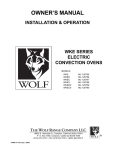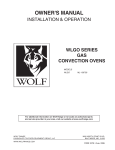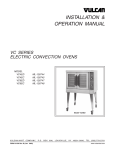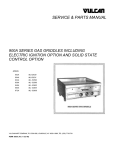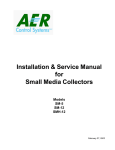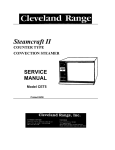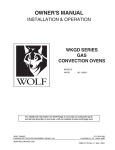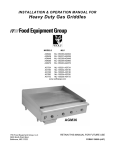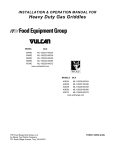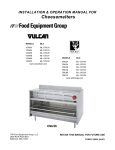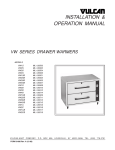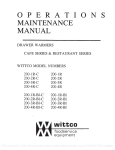Download Wolf ML-136825 Owner`s manual
Transcript
OWNER'S MANUAL INSTALLATION & OPERATION WLEO SERIES ELECTRIC CONVECTION OVENS MODELS WLEO ML-136825 For additional information on Wolf Range or to locate an authorized parts and service provider in your area, visit our website at www.wolfrange.com WOLF RANGE DIVISION OF ITW FOOD EQUIPMENT GROUP, LLC 3600 NORTH POINT BLVD. BALTIMORE, MD 21222 WWW.WOLFRANGE.COM FORM 32709 (Oct. 2008) Installation, Operation and Care of WLEO SERIES ELECTRIC CONVECTION OVENS KEEP THESE INSTRUCTIONS FOR FUTURE USE Your Wolf Electric Convection Oven is produced with quality workmanship and material. Proper installation, usage and maintenance of your oven will result in many years of satisfactory performance. The manufacturer suggests that you thoroughly read this entire manual and carefully follow all of the instructions provided. GENERAL The WLEO Series Electric Convection Ovens feature a 500°F thermostat, timer, porcelain interior and a two-speed, 1/2 HP blower motor as standard equipment. Ovens equipped with standard voltages are 208 or 240 V, 60 Hz, single- or three-phase. Ovens equipped for 480 V, 60 Hz, three-phase electrical specifications are optional. The WLEO Series Oven is a single cavity oven furnished with five racks. Independently opening doors are standard. Oven lights with on-off switch are standard on all models. An open stand with lower storage rack is available as an option. Stacked ovens are furnished with either Stacking Kit 426983G3 (8" LEGS) or Stacking Kit 426984G3 (CASTERS) for mounting one oven on top of the other. Additional racks are available as accessories. Features of the models are shown below: © THE WOLF RANGE COMPANY LLC, 2008 –2– INSTALLATION UNPACKING Immediately after unpacking the oven, check for possible shipping damage. If the oven is found to be damaged, save the packaging material and contact the carrier within 15 days of delivery. Prior to installation, verify that the electrical service agrees with the specifications on the oven data plate, located on the inside of the top front cover. Do not use the doors or their handles to lift the oven. LOCATION The installation location must allow adequate clearances for servicing and proper operation. There must be 18" (457 mm) of clearance on the right side of the oven from any open flame. INSTALLATION CODES AND STANDARDS In the United States, install the oven in accordance with: 1. State and local codes. 2. National Electrical Code, ANSI/NFPA-70 (latest edition). Copies may be obtained from The National Fire Protection Association, Batterymarch Park, Quincy, MA 02169-7471. 3. NFPA Standard #96, Vapor Removal from Cooking Equipment (latest edition). Copies may be obtained from The National Fire Protection Association, Batterymarch Park, Quincy, MA 02169-7471. In Canada: 1. Local codes. 2. CSA C22.1 Canadian Electrical Code (latest edition). 3. CSA C22.2 No. 109 Commercial Cooking Equipment (latest edition). The above are available from the Canadian Standard Association, 5060 Spectrum Way, Suite 100, Mississauga, Ontario, Canada L4W 5N6. INSTALLING BASIC OVEN The oven must be installed on legs or mounted on a modular stand. Installations on concrete bases or other supports restricting air circulation underneath the oven is not advisable and may void the warranty. If using the modular stand, set the oven on the stand after unpacking. Assembling the Legs to the Oven The legs must be installed on the bottom of the oven. Gently position the oven on its left side, taking care not to scratch or damage the oven. Attach each of the four leg assemblies to the bottom of the oven with the 24 bolts and lockwashers (six per leg). Carefully raise the oven to its normal position. –3– Ovens Mounted on Casters If the oven is to be installed on casters, assemble the casters to the legs provided. Then attach the caster-leg units to the oven at each corner using the 24 bolts and lockwashers (six bolts and lockwashers per leg). Place the locking casters on the front legs and nonlocking casters on the rear legs. BACK ASSEMBLING THE STAND TO THE OVEN Attach each of the four leg assemblies to the bottom of the oven with the 24 bolts and lockwashers (six per leg). Carefully raise the oven to its normal position. Attach the undershelf to the legs with eight bolts and lockwashers (two per leg). FRONT Install the rack guides into the undershelf at desired locations (for pan or flat rack), then attach the rack supports to the top end of the rack guides. Attach rack supports to the leg assembly by removing one middle bolt and reattaching back through the end holes in the rack support (Fig. 2). PL-53274 Fig. 2 ASSEMBLING STACKED OVENS Unpack the ovens and the stack kit. Position the oven to be used as the bottom oven on its left side for access to the oven bottom, taking care not to scratch or damage it. STACKING FLUE Attach the four leg assemblies with the 24 bolts and lockwashers (six per leg). Place the lower oven (with legs) on the floor and remove two 7/16" (11 mm) diameter knockouts on each side of the top cover. Install two locating studs to the bottom of the top oven per stacking kit instructions. Move the oven with legs to the installed position. Place the upper oven on top of the lower oven using the locating studs. Remove the optional rear panel, if provided, from the TOP oven. Install the Stacking Flue (Fig. 3) with the four screws provided. Replace the top oven rear panel, if provided. PL-53463 Fig. 3 LEVELING Make sure that the oven racks are level in the final installed position. If the oven is installed on legs, turn the adjustable feet in or out to level the oven front-to-back and side-to-side. If the oven is installed on casters, loosen set screws and turn casters in or out to level the oven front-to-back and side-to-side. Retighten set screws after leveling. –4– ELECTRICAL CONNECTIONS Electrical and grounding connections must comply with the applicable portions of the National Electrical Code and/or other local electrical codes. Disconnect the electrical power to the machine and follow lockout / tagout procedures. Remove the wiring compartment cover on the front of the oven. Remove the appropriate knockout on the bottom of the oven and attach the power supply conduit to the bottom of the oven. Comply with the appropriate wiring diagram (located inside the right side panel) when making connections to the electrical supply lines. Replace the wiring compartment cover and right side panel. Turn on the power supply. ELECTRICAL DATA TOTAL KW Single Oven Stacked Oven 12.5 25 208-240 V 480 V 3-PHASE LOADING 3-PHASE LOADING KW PER PHASE KW PER PHASE L1-L2 L2-L3 L1-L3 L1-L2 L2-L3 L1-L3 4 4 4.5 4 4 4.5 8 8 9 8 8 9 NOMINAL AMPERES PER LINE WIRE 3-PHASE 240 V 480 V 208 V L1 35 70 L2 33 66 L3 35 70 L1 33 66 L2 29 58 L3 33 66 L1 L2 L3 14.4 15.3 15.3 28.8 30.6 30.6 1-PHASE 208 V 240 V 60 120 52 104 ELECTRICAL CONNECTIONS (Stacked Ovens) Electrical and grounding connections must comply with the applicable portions of the National Electrical Code and/or other local electrical codes. Disconnect the electrical power to the machine and follow lockout / tagout procedures. Make sure that the electrical power supply agrees with the specifications on the oven data plate, the wiring diagram on the oven and Electrical Data, page 5. 1. Wires to connect both ovens are provided with each oven. Carefully route these leads from the top oven through the bushing (supplied with the stacking kit) through the electrical access knockout holes common to both ovens. 2. Connect wires X, Y and Z from the upper oven to the lower oven per the wiring diagram using wire nuts provided. Attach the power supply conduit to the bottom of the lower oven. Connect the power supply leads to the line side of the terminal block on the bottom oven. 3. Finally, inspect and check all wiring and terminal connections for tightness or pinch points (cover on oven frame). 4. Refer to reference drawing 426986 supplied with the stacking kit for electrical connection instructions. 5. Refer to instructions supplied with the stacking kit for marking the combined electrical load information to the electrical data plate of the bottom oven. –5– OPERATION The oven and its parts are hot. Use care when operating, cleaning or servicing the oven. CONTROLS — MODEL WLEO MOISTURE VENT DAMPER – Open the damper to exhaust excess moisture. Close the damper when cooking dry products. Select settings between OPEN and CLOSED for optimum performance. MASTER SWITCH – ON - Turns oven control circuits on. – OFF - Turns oven control circuits off. – OVEN COOL - Allows the fan motor to run with the doors ajar to speed oven cooling. ON LIGHT (Amber) – Lit when MASTER SWITCH is turned to ON. HEAT LIGHT (White) – Comes on and goes off when the heating elements cycle on and off. TEMPERATURE – Controls oven temperature. TIMER – Use to set the cooking time. Alarm sounds continuously when time has elapsed to 0. Turn the timer OFF to silence the alarm. The timer does not turn the oven off. Keep timer set to OFF when the oven is not in use. FAN SPEED – Adjust air velocity in the oven cavity. HI - Normal operating speed. LOW - Use this setting when cooking a delicate product like meringue, which could blow around in the oven. LIGHTS – ON - Turns the interior lights on. – OFF - Turns the interior lights off. –6– BEFORE FIRST USE Before using the oven for the first time, it must be burned off to release any odors that might result from heating the new surfaces in the chamber. 1. Using a clean damp cloth, wipe the inside of the oven, including the racks. 2. Close the oven doors, turn the MASTER SWITCH to ON, turn the Thermostat to 300°F (149°C) and allow the oven to cycle for 6 to 8 hours before turning the MASTER SWITCH to OFF. USING MODEL WLEO Preheating 1. Turn MASTER SWITCH to ON. Amber ON light will come on, indicating that power to oven is on. 2. Set Thermostat as desired. Refer to COOKING GUIDELINES for suggested temperatures and times for various products. 3. Prepare product and place in suitable pans. When white HEAT light goes off, oven has reached desired preheat temperature. Cooking 1. Open doors and load the product into the oven. Place pans in the center of the racks. Close doors. 2. Set the Timer. After the preset time lapses, turn Timer to OFF position to stop alarm. 3. When product is done, open doors and carefully remove cooked product from the oven. Care should be taken when wiping up any spills, as oven is still hot. End of Day 1. Turn Thermostat to OFF. 2. Turn MASTER SWITCH to OVEN COOL. Leave doors open while the fan is on to cool the oven. 3. When oven has cooled sufficiently, turn MASTER SWITCH to OFF and clean the oven. –7– PROPER UTENSILS The use of proper utensils can enhance oven operation. Medium and lightweight pans allow the product to warm faster. Roast meats in shallow pans deep enough to hold all juices yet allow free air circulation. OPERATING HINTS When using the convection oven for the first time with a particular food, check the degree of doneness periodically before the suggested time has elapsed. This will ensure the desired doneness is achieved. Record your temperature and time settings for various products. The convection oven can provide consistent and repeatable results. The convection oven is faster than conventional deck-type ovens; temperature settings are lower and cook times are shorter. Since recipes and foods are subject to many variations and tastes, the guidelines regarding Times and Temperatures in this manual are SUGGESTIONS ONLY. Experiment with your food products to determine the cooking temperatures and times that give you the best results. NOTE: For a more even bake, place the pans horizontally in the center of the oven rack and decrease the suggested cooking temperature by 50°F (10°C). –8– COOKING GUIDELINES The information in the Cooking Guidelines chart is suggested only. Cooking times for various products may be different depending on the brand, consistency and the chef’s preferences for taste and presentation. The times below may require adjustments. Note the times and temperatures of your preferred results for future use. The preheating time for all of the following is 15 minutes. Product Amount lbs. (kg) Cooking Temp. °F (°C) Cooking Time Hours Max. Internal Cook Temp. °F (°C) Prime Rib Rib Eye Boneless 20 (9.06) 12 (5.43) 225 (107) 225 (107) 5 3 140 (60) 140 (60) Top Round Steamship Round 20 (9.06) 20 (9.06) 225 (107) 225 (107) 5 7 140 (60) 140 (60) Bottom Round Boneless Strip Loin 20 (9.06) 12 (5.43) 225 (107) 225 (107) 5 3 140 (60) 140 (60) Whole Tenderloin Top Sirloin Butt 6 (2.71) 14 (6.34) 225 (107) 225 (107) 2 3 140 (60) 140 (60) Beef Short Ribs Cube Steaks 10 (4.53) 10 (5.43) 225 (107) 225 (107) 4 3 165 (74) 180 (82) Beef Back Ribs Beef Stew 30 (13.6) 10 (5.43) 225 (107) 225 (107) 5 4 175 (79) 175 (79) Corned Beef Fresh Ham 12 (5.43) 12 (5.43) 250 (121) 250 (121) 4 6 165 (74) 165 (74) Cooked Cured Ham Pork Back Ribs 12 (5.43) 10 (4.53) 250 (121) 250 (121) 4 5 135 (57) 175 (79) Pork Spare Ribs Fresh Sausages 30 (13.6) 10 (4.53) 250 (121) 225 (107) 5 2 175 (79) 175 (79) Pre-Cooked Sausage Roast Suckling Pig 10 (4.53) 30 (13.6) 250 (121) 250 (121) 1 3 /4 6 160 (71) 170 (77) Bacon Roasted Chicken 10 (4.56) 350 (177) 350 (177) 40 min. 45 min. N/A 165 (74) 10 (4.56) 250 (121) 21 /2 170 (77) 3.25 (1.47) 20 (9.06) 250 (121) 230 (110) 21 /2 61 /2 170 (77) 170 (77) Bone In Turkey Breast Roast Duckling (per duck) 10 (4.53) 4 (1.81) 250 (121) 350 (177) 5 11 /2 160 (71) 170 (77) Rack of Lamb per tray Lamb Shanks, Braised Fish Filets 15 racks 250 (121) 31 /2 160 (71) 4-6 oz. (23g) 250 (121) 225 (107) 4 40 min. 180 (82) 160 (71) Chicken Pieces (per tray) Whole Chickens (per chicken) Whole Turkeys Clear Soups Frozen Pizza Rice Baked Potatoes 1/1 Gastronome or 12x20x4" Steam Pan (2) 18” Pies 1 Qt. dry 225 (107) 3 175 (79) 350 (177) 250 (121) 15 min. 2 175 (79) 160 (171) 90 CT. 350 (177) 1 200 (93) –9– STANDARD COOKING TIME CHART Product Amount Temp. Time Frozen Croissant Dough 1.75 oz. 350°F (177°C) 25 Min Cinnamon Croissant 1.75 oz. 350°F (177°C) 35 Min. Small Bread Loaves 1 Tray 350°F (177°C) 30 Min. Large Bread Loaves 1.5 lbs. 350°F (177°C) 60 Min. Sheet Cake (1) 18x26" Tray 300°F (149°C) 25 Min. Scone Mix 1 Tray 350°F (177°C) 30 Min. Muffin Mix 1 Tray 350°F (177°C) 30 Min. Kaiser Rolls 1 Tray 350°F (177°C) 16 Min. Italian Bread 1 Tray 350°F (177°C) 40 Min. Danish Rounds* 1 Tray 350°F (177°C) 30 Min. Cream Cake* 1 Tray 350°F (177°C) 60 Min. Cookies 1 Tray 325°F (163°C) 16 Min. *The maximum internal cooking temperature should be 190°F (88°C). POWER OUTAGE In case of a power outage, the oven will automatically shut down. When power is restored to the lines, the oven will resume its normal operation. However, if the oven is to be left unattended during a power outage, push the MASTER SWITCH to the OFF position. When power is restored to the lines, push MASTER SWITCH to the ON position, wait for the oven to preheat, then resume normal cooking operations. CLEANING Disconnect the electrical power to the machine and follow lockout / tagout procedures. • Clean outside of the oven daily by wiping with a clean, damp cloth. • Clean porcelain oven interior daily with soap or detergent and water. Rinse thoroughly and wipe dry with a soft, clean cloth. – 10 – MAINTENANCE The oven and its parts are hot. Use care when operating, cleaning or servicing the oven. Disconnect the electrical power to the machine and follow lockout / tagout procedures. The fan motor comes with sealed bearings and requires no lubrication. Annually check the vent, when cool, to be sure it is free of obstructions. REPLACING LAMPS 1. 2. 3. 4. 5. Allow oven to cool. Remove all racks by pulling forward, lifting up and out. Unscrew glass dome(s) from light body. Replace the bulb(s). Reassemble glass dome(s) and racks by reversing the disassembly procedure. SERVICE AND PARTS INFORMATION To obtain service and parts information concerning your WLEO Oven, contact the Wolf Range Service Depot in your area. – 11 – FORM 32709 (Oct. 2008) – 12 – PRINTED IN U.S.A.












